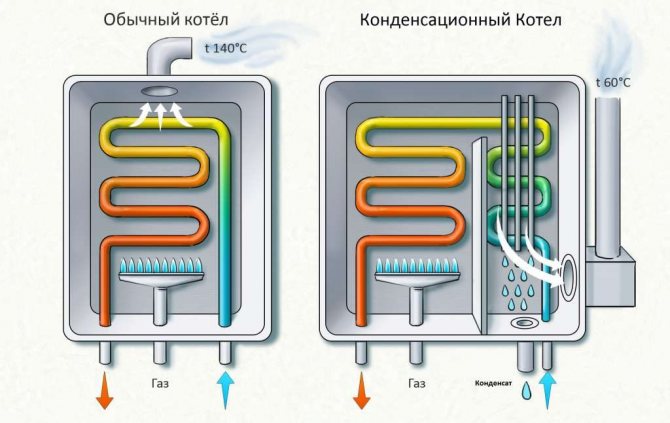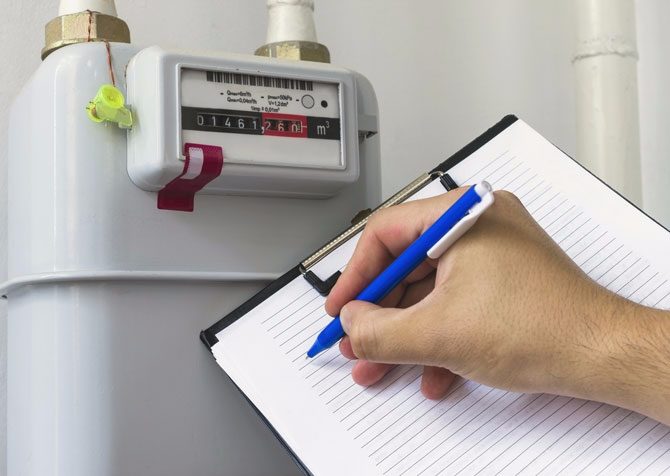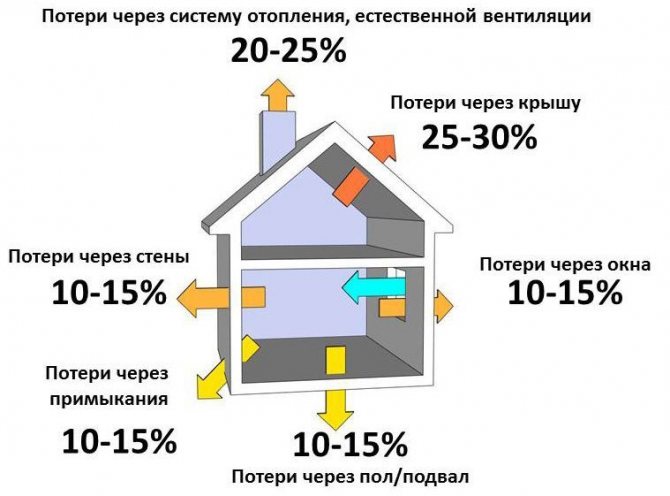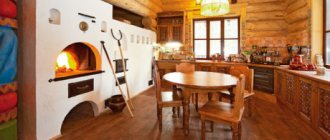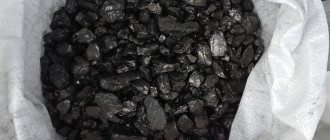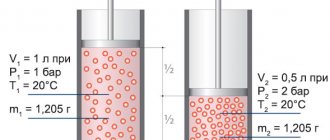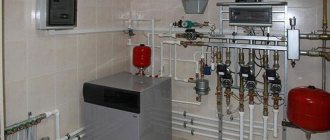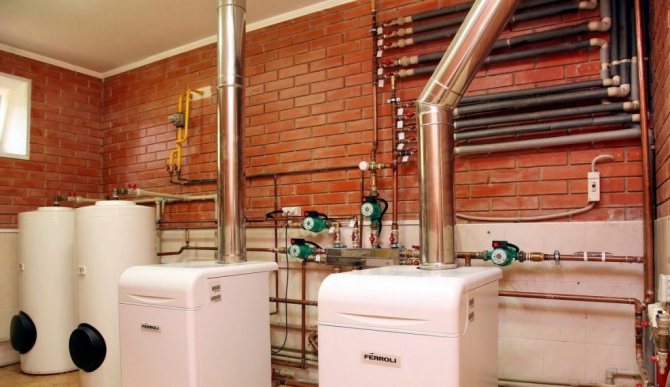
In 99.99% of cases, a customer buying a gas boiler asks about its consumption. Piously relying on the "expert calculations" of sellers and trusting them, sometimes it is often burned. Some clients who hear more real numbers from us run away to the place where the number was lower and still buy the boiler there. Since you do not find yourself in a field of lies and find out a more detailed figure for gas consumption in order to understand whether you should buy a boiler or not. For this, this article was created.
What determines gas consumption
An important issue on which material costs depend. Factors:
- boiler power;
- heat losses;
- calorific value of gas.
The boiler is the main heat generator; comfort and gas consumption depend on performance. The heater can be:
- convector;
- with an open combustion chamber;
- with a closed combustion chamber;
- condensation.
Convector - air heater. Convection is used: forced, natural. The gas burns in the combustion chamber, passing through the heat exchanger, is discharged to the outside. Cold air enters the heat exchanger through the lower part of the housing, heats up, and goes out into the room. Fans are used to speed up the process.
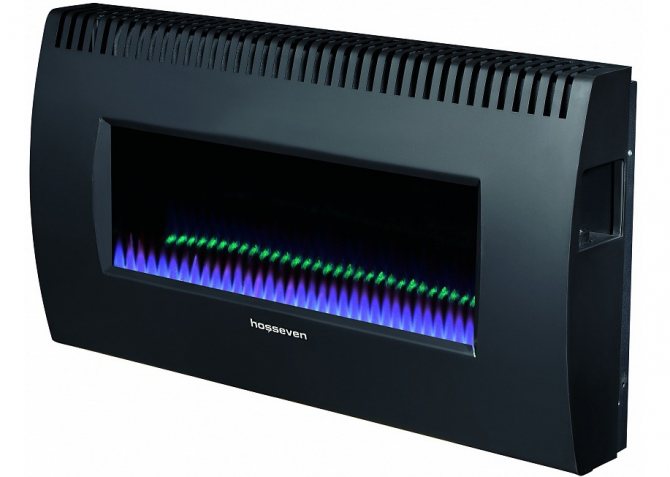

Gas convector
The firebox can be of two types:
- open;
- closed.
In an open firebox, oxygen is taken from the room air, the combustion products are removed outside.
Heaters with an open chamber can be installed in non-residential areas. This is related to safety.
In a closed chamber, oxygen enters together with the outside air and is discharged outside. The systems are safer, more productive. Convectors are characterized by low efficiency, about 86%, are used to heat small rooms.
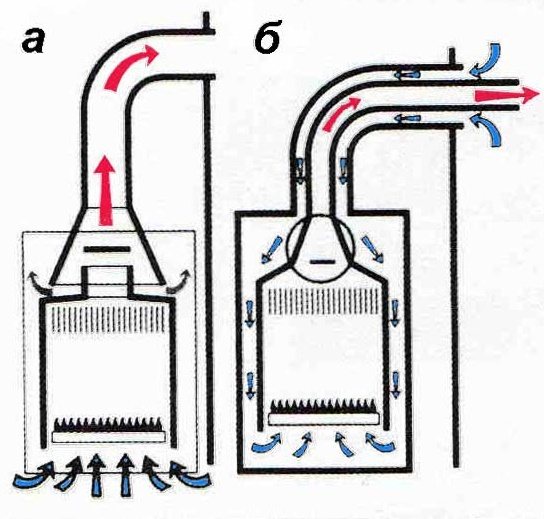

Boiler diagram with: a) open; b) closed firebox
Gas boilers are similar in structure, but they heat water, which has a higher thermal conductivity than air, and the efficiency is higher. The difference is the way of transferring heat. The water heated in a heat exchanger (another heat carrier) is transferred by a pump to radiators in different parts of the house. It is possible to transfer heat over long distances. The efficiency of boilers with an open chamber is 88%, a closed one - 92%.
In order to increase the efficiency of the boiler, they try to remove heat from the combustion products. They came up with a condensing boiler. It works like a conventional one, but has two heat exchangers: the first is a conventional one, it takes heat from the combustion products, the second is installed in the path of the exhaust gases. The heat carrier taking heat from gases must have a temperature not higher than 55 ° C. Exhaust gases cool down, water is released - condensate, which can be used for technical purposes. The efficiency can be increased up to 96%.
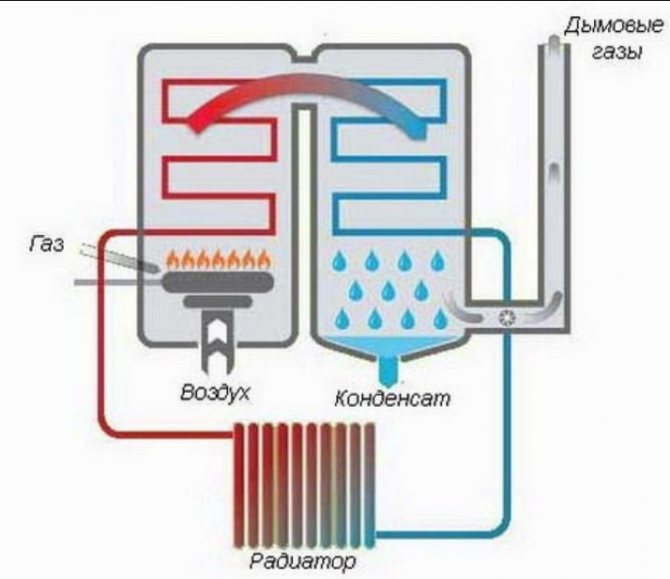

How does a gas condensing boiler work
The lower the heat loss, the lower the gas consumption.
An example of calculating gas consumption for heating a private house from the network
An illustrative example will help to better understand the specifics and features of calculations. This calculation can be applied both for an apartment and for a country house. First, you need to collect the initial data.
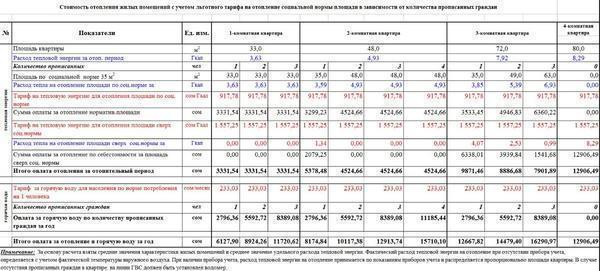

Initial calculation parameters:
- Premises area - 100 m2;
- Boiler power - 10 kW;
- The efficiency of the heating unit is 95%.
First, joules should be converted to kilowatts. 1 kW has 3.6 MJ. It should also be understood that the rate of 10 kW is used to heat the house in the coldest times. But there are not so many especially cold days during the season.
If you correctly calculate and arrange the operation of the boiler, then it makes no sense for the unit to work constantly.
On more favorable winter days, you do not need so many kilowatts for heating. That is why it is customary to divide this parameter in half during calculations.Further, the obtained data is substituted into a special formula. And by multiplying the indicator by tariffs, you can calculate the economic part of gas consumption.
Having learned the required amount of fuel per hour, you can make calculations for the entire season. So the resulting number should be multiplied by 24 and get the consumption rate per day. Further, the obtained data are multiplied by 30 and the required amount of gas per month is obtained. Seasonal calculation takes into account heating for 7 months.
How much energy does a home heating system consume?
Heat losses include conditions, factors that lower the temperature in the house. It is impossible to take everything into account, let's highlight some:
- geographic point;
- heated area;
- if the apartment is heated - where it is located;
- exterior wall material;
- ventilation;
- heat consumption for additional needs.
The first point refers to the climatic zone, the further north, the greater the loss. The location of the house on the ground. For example, a house located separately, on a hill, is exposed to more wind loads than a house protected by other buildings in a low place.
The second point is more correct to name the heated volume, the increase in the ceiling increases the area of the outer walls that introduce losses. The exception is that a basement room of the same volume loses much less heat than the upper room.
The apartment in the center of the house has losses only through one outer wall, the upper corner one - two street walls plus a ceiling connected to the attic, a roof. The southern premises receive additional heating from the sun, which cannot be said about the northern location.
Thermal insulation of walls is the most important point in saving heat. Most of all come into contact with the outside air, even a slight decrease in heat loss can give results. When building, designing, it is worth thinking about the building material. If the building is built, it is necessary to assess the thermal conductivity of the walls, insulate it. The costs will pay off by reducing gas consumption.
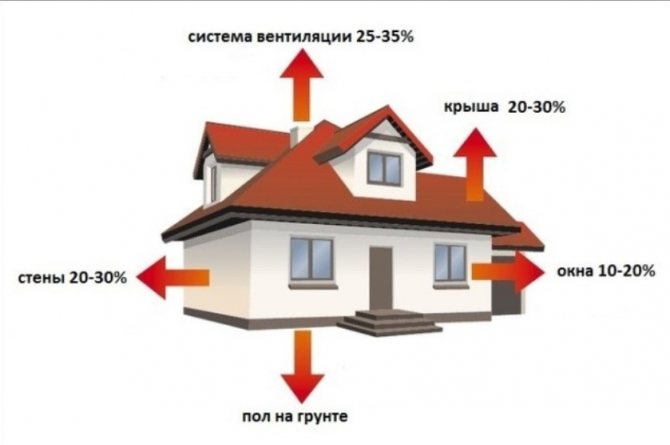

Heat loss diagram
Ventilation is a weak point. Correctly adjusted, serviceable will provide the necessary oxygen, save the generated heat. Some people use window, door slits as ventilation, however, the approach is not justified by common sense. Cracks can appear in a wall that has not been renovated at home.
The last item on the list includes gas stoves, hot water supply, hot water supply. Heating takes place indirectly through an additional heat exchanger. The higher the DHW consumption, the more gas will be consumed.
After determining the heat loss, the energy to be replenished can be calculated. There are formulas, tables, but they are difficult to understand. You can use the simplified diagram shown in the table:
| External surfaces | Loss, W / m2 |
| wall, wall with window | 100 |
| corner two walls, window | 120 |
| two walls, two windows | 130 |
Shown are losses for external walls, windows, you must select a line, measure the area of the room. For example, if we have a wall with one window, the losses will be 100 W / m2. The length of the room is 4 m, the width is 2.75 m, the work is 11 m2. Multiply by 100 W / m2, we get 1100 W or 1.1 kW. Calculations are carried out in all rooms, the result is summed up.
Average calculator for calculating gas consumption for heating a house
It is quite easy to find out the gas consumption for the last season. It is enough to take into account the monthly indicators of the counter. When the heating season comes to an end, you just need to add up all the data.
Further, the arithmetic mean is considered. But to calculate the required amount of gas at the stage of buying a boiler, you will need to use a special formula. Gasification of an autonomous system of a private house, summer house or apartment implies the use of an average calculator, while determining heat loss. This is just a rough estimate.
Methods for calculating the specific heat consumption:
- Depending on the total area of the heated rooms. Here they rely on the climatic conditions of the region. For 1m2, approximately 30-40 watts will be needed.
- Given the total area of the building. So each square meter of a room with a room height of 3 m requires 100 watts of heat. You will also need to take into account the climate of the region.
The main thing in the calculations is to take into account the required boiler power, which is able to provide the premises with the required heat. When calculating, they are guided by the average indicator, for which 1 kW of energy is used per 10 m2. Although this calculation is the simplest, it cannot take into account all the features of the region and the building itself.
The average calculator assumes that 1 kW of heat energy is needed for 10 squares of area.
The calculation of gas use will help not only to choose the right boiler, but also to reduce the cost of gas consumption. This will help save on heating costs. So you can insulate the house and find ways to reduce heat loss.
How much gas needs to be burned to generate 1 kW
Depends on the calorific value of the fuel, the higher the indicator, the less fuel is needed. Heat is usually measured in J / kg, J / m2, J / L. The task is to determine the calorific value, to bring it to the required value. For heating use:
- methane;
- propane;
- butane;
- propane-butane.
To convert J to kW, use the ratio: 1 MJ = 0.278 kW / h.
Propane, butane, their mixture have different purification, calorie content varies. The volume and weight of the gas are very variable. Temperature, pressure greatly affect the performance. This is due to the large expansion coefficient, in comparison with water, 16 times more. To compare indicators, the test substance must be under the same conditions (temperature, pressure, product purity).
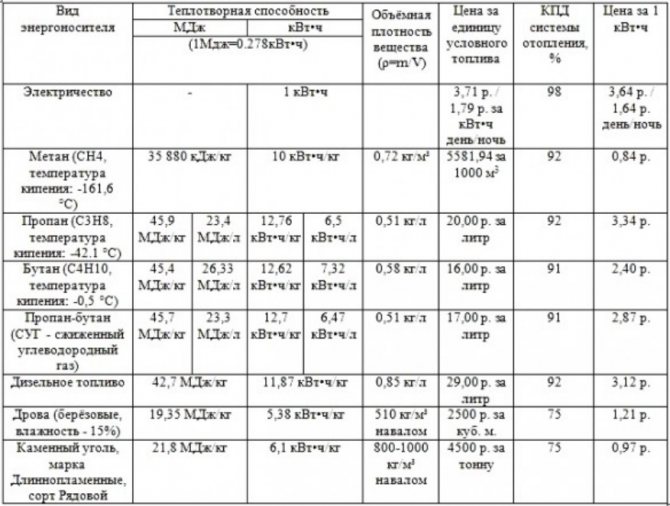

Calorific value of fuel
Another indicator that affects the amount of heat received is the boiler efficiency. Depending on the design, the average performance is determined:
- gas convector 86%;
- open type boiler 88%;
- closed combustion chamber 92%;
- condensing gas boiler 96%.
The given figures are averaged, the performance is influenced by many factors, for example, the material of the heat exchanger. May be:
- steel;
- cast iron;
- aluminum;
- copper.
The efficiency may deteriorate, the heat exchanger plates are burnt, clogged with soot.
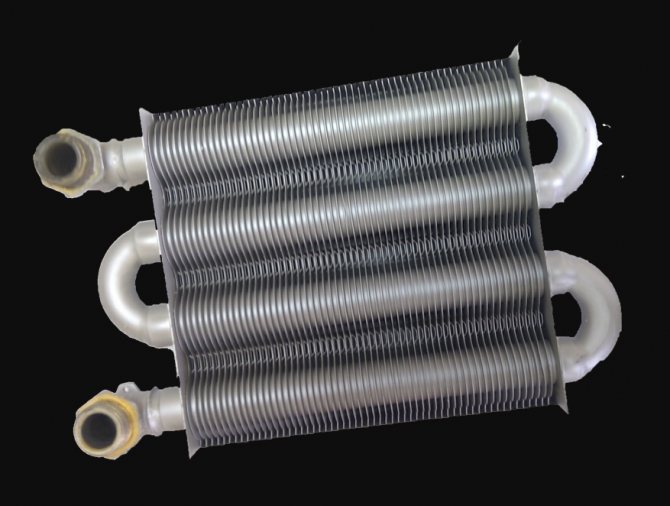

Gas heat exchanger
Gas boiler consumption
When starting the choice of a gas boiler, it is necessary to master a significant layer of information that allows you to compare the characteristics and calculate what consumption of gas heating boilers in the available price range will be the most profitable. It should be understood that the microclimate in your house, the consumption of liquefied gas of gas heating boilers, the amount of heated water for use for various purposes will depend on which boiler you choose.
General classification
The main offers of the heating appliance market in the category "gas heating boiler" can be subdivided into the following categories:
- boilers are atmospheric or turbocharged (depending on the type of chimney used; classic or coaxial);
- single-circuit or double-circuit boilers (the latter, in addition to heating the premises, can also provide hot water supply);
- condensing boilers (using waste gases to heat water and only then a gas burner).
At the same time, the gas consumption of gas heating boilers of different categories differs very significantly, due to which the purchase of a gas boiler with a lower consumption at a higher price can bring tangible benefits in the future.
Gas consumption of gas heating boilers of various types and their price
Today, for gas boilers of the same power, the following rule can be considered fair - the lower the consumption of gas heating boilers, the higher their price.So, for example, condensing boilers, initially more expensive than boilers of other categories, will save their users 15-17% and are the most profitable.
The consumption of liquefied gas of gas heating boilers of the double-circuit type is practically the same as that of single-circuit boilers. However, despite their slightly higher price, they will allow you to save significant money on hot water supply, and thanks to this, they will quickly pay off.
The same trend can be seen when comparing atmospheric and turbocharged gas heating boilers - the gas consumption of the second is lower at a higher price. It should also be noted that turbo boilers do not burn oxygen in the room.
How to find out the consumption of gas heating boilers?
It all depends on whether it is necessary to find out exactly the consumption (that is, how many kilograms of liquefied, or cubic meters of natural gas the boiler burns per hour), which is indicated in the documents, or how much gas the boiler will burn under certain conditions per month.
In the second case, there is a generally accepted constant, according to which, with a well-designed heating system in winter, a gas boiler works on average about 14 hours a day (except for double-circuit boilers, they work more due to the need to provide hot water supply).
Thus, the estimated gas consumption of gas heating boilers per month in the winter period can be calculated using the formula R = r * 14 * m. Where R is the flow rate per month, r is the flow rate per hour for the peak load of the device (indicated in the documents), 14 is the average duration of the boiler operation per day (may differ for different climatic zones and specific boilers), m is the number of days in a month. At the same time, gas is also consumed in summer (for heating water for domestic needs), unless, of course, a backup electric boiler is installed.
However, such a calculation is very approximate and most likely, the figures obtained in practice will be seriously different, and therefore, the installation of the meter when installing the boiler is strictly mandatory. Otherwise, the installation of gas heating equipment will not justify itself and the payment for gas will exceed the payment for centralized heating.
Average statistical gas consumption per month, day, hour
How to calculate how much gas is consumed? It can be done approximately, it is impossible to take into account all the factors. Data:
- calorific value of gas;
- Heater efficiency;
- heat loss of the building;
- additional costs (for example, hot water supply system for hot water supply).
For the calculation, you can use the formula: V = Q / (q x efficiency / 100).
A simplified version, you can get an idea of the upcoming costs. Explanation of designations:
- V is the calculated gas volume;
- Q is the required heat;
- q is the calorific value of the gas.
Gas volume strongly depends on temperature, pressure; the volume of gas vapors at normal atmospheric pressure is taken into account. From 1 kg of the liquid phase of the gas, approximately 450 liters of vapor are obtained. To calculate how much heat is needed for heating, the heat loss of walls, doors, windows, floor, ceiling is calculated. If there is ventilation, add an indicator. When using hot water, the V value is multiplied by a factor of 1.15. The calorific value of the gas is determined from the tables, converted to kW.
As an example, you can calculate for a house with an area of 100 m2. Based on the table, we determine the average loss of 120 W / m2h, translate into kilowatts, it turns out 0.12 kW / m2h. We multiply by the total area of the house, we get 12 kWh - the Q indicator.
A liquefied mixture of propane-butane gas with a calorific value of 11.5 kW / kg is used. Boiler with a closed chamber, productivity 92%. It remains to insert indicators into the formula. V = 12: (11.5 x 92: 100) = 12: 10.58 = 1.13 m3 / h. It will turn out to be 1.13 x 24 = 27.12 per day, 813 m3 per month.
The result will be about half that. Heat losses are taken for extreme conditions - the coldest day in winter.There are not many such days in the heating season, the result is usually divided by 2.
How to calculate fuel consumption yourself?
To understand why a gas boiler consumes a lot of gas, you first need to make calculations of fuel consumption. You can do this yourself. The two main parameters to consider are equipment capacity and building area. Manufacturers on average recommend starting from a ratio of 1 kW per 10 sq. m. But it is still more logical to measure the flow rate in cubic meters per hour. In this case, the average value: 1 kW of power - 0.112 cubic meters per hour.
Manufacturers indicate fuel consumption in the passport of boiler equipment. But they are only relevant in the case of continuous work. Therefore, the power reserve must be taken + 20% of the recommended one.
If the manufacturer claims a consumption of 2 cubic meters per hour, it is enough to multiply this value by 24 hours of work and divide by 2. We get exactly 24 cubic meters of gas per day. Multiplying by the number of days in a month, we get the monthly consumption. The heating season in Russia on average lasts 7 months.
Of course, all these values are conditional. They will depend on the operating mode of the boiler equipment, the heat loss of the building, the health of the entire system and other parameters. Therefore, the calculation of how much gas a gas boiler consumes will be individual.
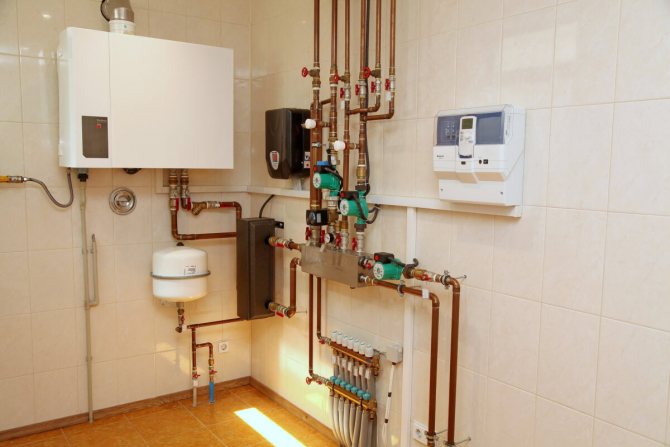

How to determine how many liters of gas a gas boiler consumes to heat a house?
There are many reasons for the increased gas consumption by the boiler, according to the owner. But the main factor remains the power of the system. The higher the power, the greater the consumption. And owners often increase this power themselves for many reasons:
- severe frosts on the street;
- the heat sink is clogged, which worsens the quality of heating;
- the second circuit is used (if available);
- low-calorific gas, etc., enters the system.
We have already said that the average calculation of power is 1 kW per 10 square meters of housing. But in extreme cold, you can safely add 20% to this value. We get not 1 kW, but 1.2 kW.
Based on this, you can make simple calculations:
- Use your home plan to calculate the total area of all heated rooms. Including warm corridors.
- Divide this value by 10 and multiply by 1.2 (for a particularly cold period).
- Next, round off the resulting number to the standard power of the boiler equipment - 7, 10, 12 kilowatts, etc. So you get the power that will show how much your boiler should consume in standard operation.
Let's say you have an apartment with an area of 40 sq. m. We consider this: 40 divided by 10 and multiplied by 1.2. We get the number 4.8. Round up to 5 kW - typical boiler output.
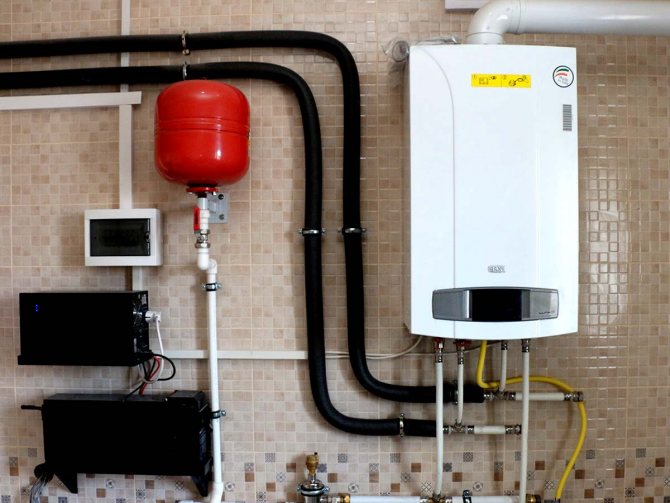

How to reduce consumption
A powerful boiler makes it possible to quickly cover heat losses, however, the gas consumption increases. The issue can be partially solved by using a condensing boiler. However, the equipment is more expensive than analogs. A copper gas heat exchanger will require additional money. Cheap natural gas can be used, however, the volume of gas consumption will increase. Practical tips for saving gas:
Better to reduce heat loss. Thorough sealing of windows, doors, insulation of the building frame, economical consumption of hot water will help to significantly reduce consumption.
Definition: how much gas does a gas boiler consume per month and year
The installation of gas boilers is considered the best solution for areas with a gas supply network. Natural gas has many benefits. It is an environmentally friendly product, affordable, has a high heat dissipation. But when choosing a boiler, it is important to immediately determine how much gas the unit uses to heat different areas: from 80 m2 to 400 m2.
Factors affecting fuel consumption:
- Gas boiler power;
- House or apartment area;
- Possible heat loss (number of windows and doors, their tightness, wall thickness and other important parameters).
When buying a gas boiler for a long service, it is important to take into account all the nuances of choosing a unit.It should be understood in advance how much gas is spent on heating a certain area and volume of the building. Only with a responsible approach can you have an economical benefit from such a purchase.
Which boiler consumes gas more economically?
The answer is unambiguous - conditioned. Losses are contained in the release of warm burnt products into the atmosphere. For the rest of the boilers, the indicator is much higher. The gas unit is designed so that the heat remains in the building. The efficiency will show how much heat remains in the room. Some manufacturers go for a trick, the boiler has an efficiency of more than 100%. It turns out that the boiler gives off more heat than the fuel can give - a complete absurdity.
To save on heating, you need to choose the fuel wisely, adjust the system, and insulate the building.
Electricity consumption
Having studied the reasons affecting the gas consumption, it can be understood that the fuel consumption by the system largely depends on the power of the equipment.
When buying, you cannot expect that the heater will be turned on at partial power and gas consumption will be minimal.
There are many reasons why you will have to put more power, which will increase electricity consumption:
- the heat exchanger is clogged;
- severe frosts set in;
- low-calorific gas is used;
- an additional circuit is installed.
Therefore, before starting the calculation of costs, it is necessary to determine the needs of the heating system installed in a particular house.
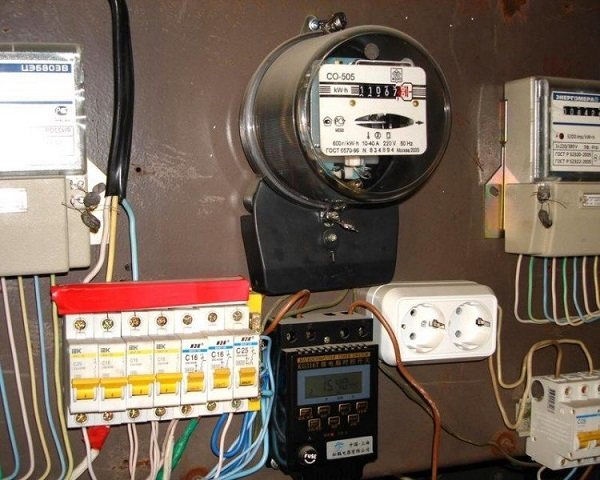

Approximate calculation of energy consumption
To calculate the energy consumption of a gas boiler, you do not need to use complex mathematical formulas and take into account the inertia of the battery, floors, the number of windows or the thermal resistance of walls. There is a simple proportion: 10 square meters = 1 kW. If a period of severe frosts has come, then another 20% should be added - 1.2 kW.
In practice, this scheme can be applied as follows:
- Find the exact plan of the house and calculate the area of the rooms to which the heating system is connected. Even warm corridors are taken into account.
- Divide the resulting figure by 10 and multiply by 1.2. This is the maximum "appetite" of the heating system. It remains to round the figure to the nearest device power (7, 10, 12, 24 kW).
As an example, you can imagine a three-room house, where there are 18, 20 and 12 squares. It is also necessary to consider the kitchen (12) and do not forget about the corridor (6). It comes out 68 squares or 8.16 kW. The indicator is rounded up to 10 kW and the power of the installation is obtained.
Using this data, you can easily find out how much electricity a gas boiler consumes, as well as gas. But you need to remember that equipment in real household conditions works at 75% of the possible power (and even less). Therefore, 25% can be safely removed from the formulas used.

